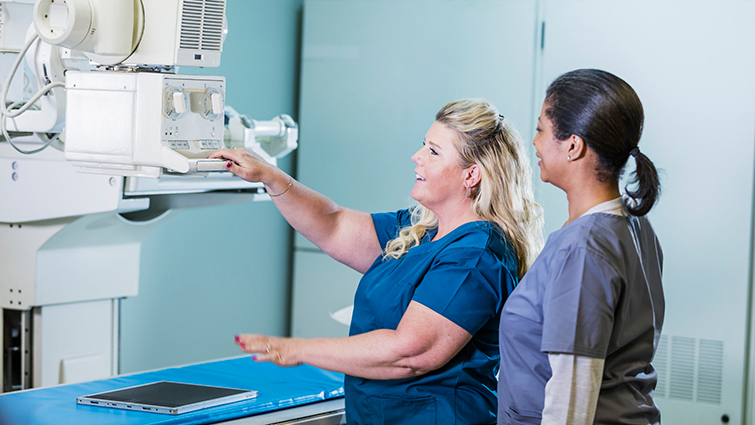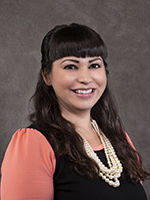Is It Time to Advance your Career?
Completing your Bachelor's Degree Online is Easier Than You Think!

Loma Linda University's Bachelor of Science in Radiation Science program is unique because it offers a flexible learning program at a competitive tuition rate. Students can choose part-time and full-time options, allowing them to work around their busy professional schedules. Average part-time students can complete their degree in 1-2 years depending on transfer credits from their entry level imaging program. You may be closer than you think! Contact us to find out!
START HERE: Attend a free online information session to gain information about this program, as well as other options for growing your career.
Program Resources
BSRS Program Components
The Bachelor's in Radiation Sciences is comprised of the following elements:
- Professional Core (a student's entry-level imaging degree, such as medical radiography) taken prior to program entry. This usually takes 2 years full-time.
- BSRS Program Core (required for all students to take): 1 year part-time.
- BSRS Area of Emphasis (customized focus of the degree): 1 year part-time.
- Loma Linda University general education requirements (General Education) for baccalaureate degrees. Contact the program director for guidance.
BSRS Program Portfolio: Part of the core curriculum, students will be required to complete an ePortfolio comprised of academic and professional work, a signature project, and service learning hours.
Program Objectives
- Provide an ethically-based leadership program that enables graduates to serve communities in the imaging professions.
- Graduate administrators, educators, imaging informatics professionals, and clinical imaging professionals who advance the imaging professions through advocacy and professional practice.
How to Begin
- Step 1: Contact the program director for advisement (work-up). Email is best. Send a copy of your transcripts if you have them, the emphasis in which you may be interested, and the state in which you live.
- Step 2: Once your unofficial work-up is completed, the program director will reach out with that information and degree planning options.
- Step 3: Apply to the program.
- Step 4: Arrange to have your official transcripts sent directly to the Office of Admissions for the School of Allied Health Professions. Official transcripts must be sent directly to LLU from the school where credits were earned.
Admissions Requirements
- The prospective student must be a graduate of an approved program (or the equivalent) in Radiologic Technology, Computed Tomography, Magnetic Resonance Imaging, Radiation Therapy, Nuclear Medicine, or Diagnostic Medical Sonography (Ultrasound) or Cardiovascular Credentialing International (RCIS or RCES).
- Prospective students should not expect admission into the program if their cumulative grade point average is below 2.5 (science and non-science subjects are computed separately).
- Prospective students are advised to apply six months prior to the quarter of entry (see program start dates below).
- Prospective students are advised to contact the program director prior to applying to discuss requirements and establish an academic learning plan.
- Prospective students from entry-level programs (medical radiography, sonography, etc.) who are eligible to take their professional board examination(s) for certification, but who have not had the opportunity to do so, are given provisional status for one quarter.
- Prospective students must reside (for the entirety of their degree) in a state that has authorized LLU to teach distance education.
Please refer to the LLU State Authorization page for additional information.
Program Start Dates
Students may apply to begin the PPBSRS program in the summer and fall terms. The application windows are as follows: SUMMER TERM (October 1 – April 1) and FALL TERM (February 1 – June 1).
Program Length
Depending on the transfer of units, emphasis selection, and degree requirements, students will be required to complete between 36 and 100 units. On average (between 2015-2021), students take 61 quarter units to complete their degree. Between 2015 and 2021, the average student took 2.25 years to complete their degree, averaging 7 units per term (half-time status). For students who do not require an area of emphasis (it is transferred in), the average is closer to 1 year.
Core Classes
All students in the PPBSRS program take these core classes to complete their degree requirements.
| Core (30 units) 1 | ||
| AHCJ 318 | Emotional Intelligence and Leadership Skills for Health-Care Professionals | 3 |
| AHRM 475 | Health-Care Research and Statistics | 4 |
| RTCH 385 | Radiologic Trends in Health Care | 2 |
| RTCH 387 | Writing for Health-Care Professionals | 3 |
| RTCH 464 | Moral Leadership | 3 |
| RTCH 467 | Management of a Radiologic Service | 3 |
| RTCH 485 | Digital Management in Radiology | 3 |
| RTCH 489 | Effective Communication for Supervisors | 3 |
| RTCH 491 | Portfolio I | 3 |
| RTCH 492 | Portfolio II 4 | 3 |
| Religion (9 units) | ||
| RELT 406 | Adventist Beliefs and Life | 3 |
| RELE 456 | Personal and Professional Ethics | 3 |
| RELR 409 | Christian Perspectives on Death and Dying | 3 |
| Area of emphasis 2 | 12-24 | |
| Electives 3 | 0-34 | |
| Total Units | 97 | |
1Core courses are online.
2Area of Emphasis selected from options listed below.
3Remaining units required for the B.S. program can be obtained from remaining emphases and other available courses offered at Loma Linda University.
4Fulfills service-learning agreement
Area of Emphasis
Students can custom tailor their degree by choosing an area of emphasis in which to focus their studies:
- Administration & Education: 1 year, 25 units – fully online emphasis
| HCBL 346 | Legal and Ethical Environment in Health Care | 3 |
| HCBL 434 | Financial Management for Health Care | 3 |
| HLIN 430 | Quality Management and Performance Improvement in Health Care | 3 |
| RTCH 414 | Practicum in Radiation Sciences | 3 |
| RTED 475 | Curriculum Development for the Radiation Sciences | 3 |
| RTED 476 | Adult Learning Theory for the Radiation Science Student | 3 |
| RTED 477 | Learning Activities and Assessment for the Radiation Sciences | 3 |
| RTSI 344 | Pharmacology for Imaging Professionals | 4 |
| Total Units | 25 | |
- Science (PA, Pre-Med, and other advanced degrees): 15-20 quarter units selected from the natural sciences in the areas of biology, microbiology, chemistry, math, statistics, or physics. Courses must be taken from two different content areas with the approval of the program director. These courses are taken at your local college/university. A minimum grade of C+ (2.3) is required for all courses.
- Clinical Practice: The didactic coursework (not including clinical units) coursework from a clinically-based imaging specialty (diagnostic sonography, cardiac sonography, nuclear medicine, radiation therapy, dosimetry,or Cardiovascular Credentialing International (RCIS or RCES) can be applied to complete the PPBSRS program
- Special Imaging - CT/MRI: This program offers certificates, as well as an emphasis in the BSRS program. This is a clinically based emphasis, expect to spend weekly hours in clinic.
- Cardiovascular Imaging: This program offers certificates, as well as an emphasis in the BSRS program. This is a clinically based emphasis, expect to spend weekly hours in clinic.
A maximum of 70 semester or 105 quarter units from an accredited community college will be accepted, not including units for clinical training. Students who have completed a hospital training program are allowed up to 50 community college-level units of academic credit on the basis of their registry certificate.
Accreditation: Assuring Quality
The BSRS program is accredited by WASC (Western Association of Schools and Colleges) which provides the option to transfer credits or to pursue other health care related options at LLU.
What can I do with this degree?
The program is highly flexible, creating a multitude of opportunities for graduates to advance career or academic goals.
- 60% of students complete the administration & education emphasis. This emphasis allows for entry-level supervision positions, employment with imaging vendors, basic instruction in the medical imaging professions, PACS administration, and many other employment opportunities requiring a BS degree.
- 20% of our graduates complete an emphasis in science, allowing them to advance in to programs such as PA (our most common), MS Radiologist Assistant, Medicine, OT and PT.
- 20% of students complete an emphasis in advanced modalities such as CT, MRI, Cardiac Imaging, Vascular Imaging, Sonography, Radiation Therapy, and Nuclear Medicine. These emphases also allow for entry into advanced degrees or employment opportunities requiring a BS degree.
For information on wage differences between degrees and certifications, visit the ASRT wage and salary survey report.
Contact Us

Brigit Mendoza, M.A.M., R.T. (R)
Program Director
[email protected]
Department of Radiation Technology
School of Allied Health Professions, Room A-829
Loma Linda, CA 92350
909-558-4931
